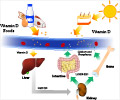Tuberculosis patients with a particular type of vitamin D receptor are very responsive to vitamin D treatment.

Vitamin D was used to treat tuberculosis in the pre-antibiotic era. The metabolic end products of vitamin D have been shown to induce anti-mycobacterial immunity in vitro, i.e. in an artificial environment outside the living body. There are no clinical trials that investigate the effect of adjunctive vitamin D on sputum culture conversion.
A multicentre randomised controlled trial of adjunctive vitamin D in adults with sputum smear-positive pulmonary tuberculosis was performed in London, UK. Vitamin D occurs in two major forms: D2 and D3. D3 (cholecalciferol) is the form made in the body in response to sun exposure. Doses of 2.5 mg vitamin D3 were given to patients receiving intensive-phase treatment for pulmonary TB. Vitamin D did not significantly affect time to sputum culture conversion in the whole study population. But it was found that sputum culture conversion hastened in people with a particular genotype.
Vitamin D receptors occur in two genetic variants or polymorphisms: TaqI and FokI polymorphisms. People with theTaqI vitamin D receptor polymorphism may further exhibit a particular genetic makeup (genotype) called tt genotype. It was in the participants with tt genotype that the positive effect of vitamin D became evident.
The findings show great promise in speeding up the antibiotic treatment of TB. The DOTS strategy implemented under the Revised National Tuberculosis Control Programme (RNTCP) in India is the international standard for TB control programmes. Treatment typically lasts for 6 to 8 months. Any headway made in the medical research field for Tuberculosis will help to improve outcomes for patients. The current study is not devoid of limitation but it does raise hopes. Being in a nation with 1.96 million new cases of TB annually, every tiny speck of hope is worth.
Primary Source: The Lancet, January 6, 2010
Source-Medindia














